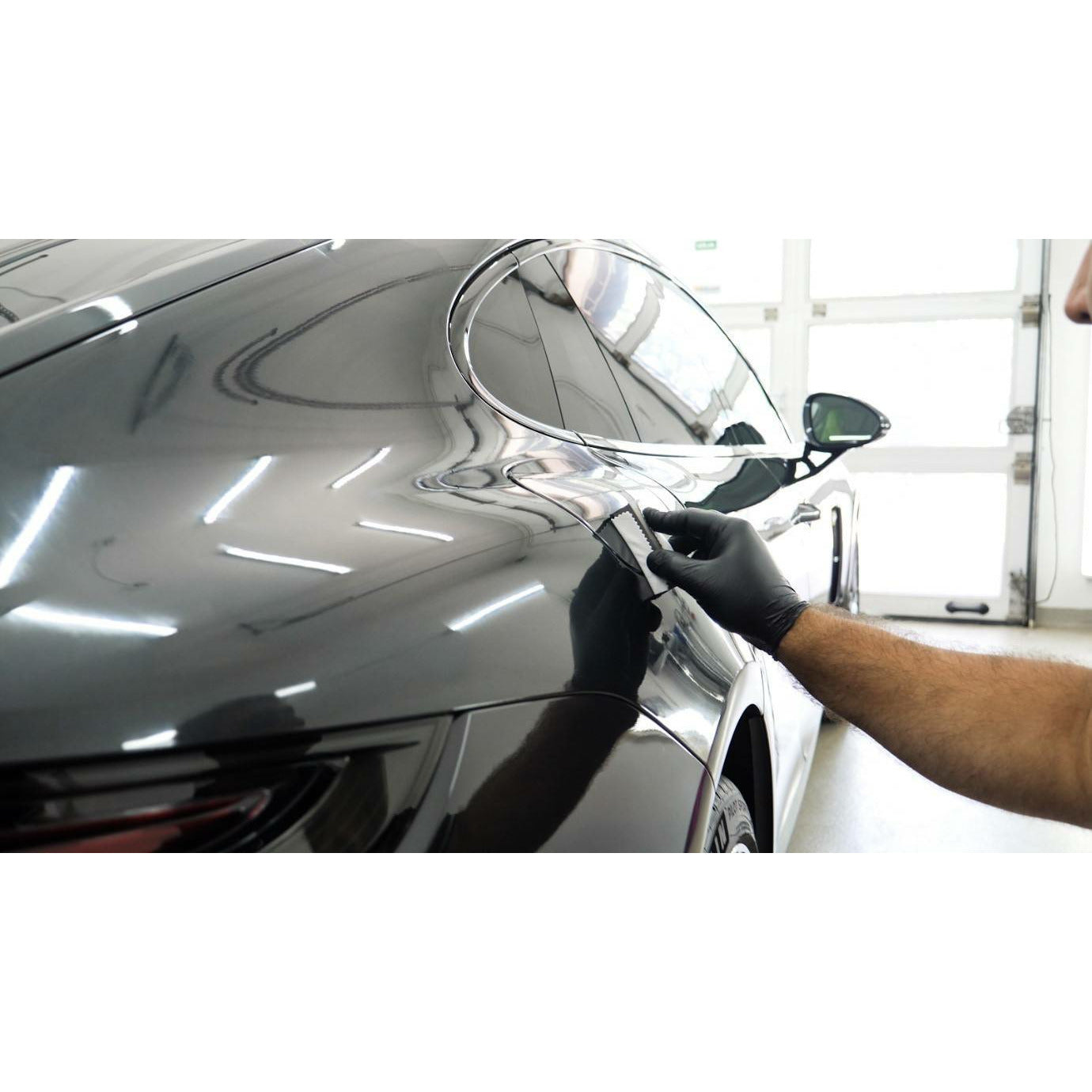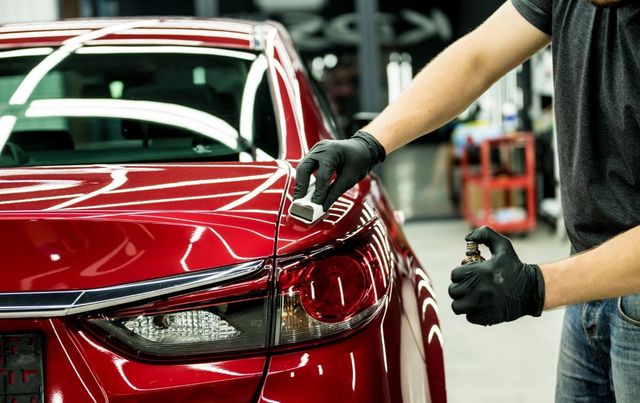Why Choosing Ceramic Coatings Is Essential for Automotive Paint Defense
Why Choosing Ceramic Coatings Is Essential for Automotive Paint Defense
Blog Article
How Ceramic Coating Boosts the Long Life of Your Vehicle's Finish
Ceramic coating has arised as a crucial innovation in automobile care, using a significant improvement to the long life of a car's surface. By creating a robust, semi-permanent bond with the factory paint, ceramic coatings provide a formidable obstacle against environmental dangers, consisting of UV rays and chemical contaminants.
What Is Ceramic Coating?
Ceramic coating is a cutting-edge safety solution that improves the durability and appearance of automotive surfaces. This innovative technology includes the application of a liquid polymer that chemically bonds with the factory paint, producing a durable layer of security. Unlike conventional wax or sealants, which supply only short-lived benefits, ceramic layers offer lasting durability against environmental contaminants and physical wear.
The main element of ceramic coatings is silica, which creates a solid bond with the car's surface. This leads to a hydrophobic effect, causing crud, dirt, and water to bead off quickly. Additionally, the coating provides UV security, decreasing the threat of oxidation and fading triggered by prolonged sun direct exposure. Therefore, automobiles treated with ceramic finishings keep their aesthetic allure in time.
Application of ceramic coating calls for careful preparation, including detailed cleansing and purification of the vehicle's surface area to make certain optimal attachment. Once applied, the coating treatments to create a semi-permanent shield that can last for a number of years when correctly kept. This cutting-edge service represents a significant advancement in vehicle care, giving a premium alternative to traditional techniques of surface area security.
Benefits of Ceramic Coating
One of one of the most substantial benefits of using ceramic coating to a car is the boosted protection it offers against environmental damages. This innovative protective layer works as a powerful barrier versus dangerous aspects such as UV rays, bird droppings, tree sap, and acid rainfall, which can cause fading, etching, and rust of the car's paintwork.
Along with safeguarding versus environmental hazards, ceramic coating substantially lowers the regularity of cleaning and detailing. Its hydrophobic buildings push back water and dust, permitting pollutants to move off even more conveniently, resulting in a cleaner surface for a longer period. This not only saves time and effort yet likewise lessens the wear and tear connected with normal washing.
Furthermore, ceramic coating supplies a high-gloss coating that enhances the vehicle's appearance, giving it a display room radiate that lasts. This visual advantage is matched by a rise in resale value, as a well-kept outside typically converts to an extra enticing offer on the marketplace.
Eventually, the advantages of ceramic coating expand past simple visual appeals, supplying useful solutions for long-term automobile treatment and preservation.
Just How Ceramic Coating Functions
At its core, ceramic coating functions with a chemical bonding procedure that incorporates with the vehicle's factory paint. This innovative coating contains nanoparticles, usually made from silicon dioxide (SiO2), which produce a robust and long lasting layer on the surface area of the paint. When applied, the ceramic coating penetrates the microscopic pores of the vehicle's surface area, developing a semi-permanent bond that enhances the paint's protective qualities.
The result is an ultra-thin, hydrophobic layer that drives away water and impurities, making it extra tough for dirt, crud, and other ecological contaminants to abide by the surface area. This function not just streamlines maintenance, as cleaning comes to be more efficient, but likewise decreases the risk of scrapes and swirl marks that can mar the coating in time.
In addition, ceramic finishes supply UV protection, shielding the paint from dangerous sunlight exposure that can cause oxidation and fading. The chemical composition of the coating makes certain that it remains undamaged under various news weather problems, adding to the long life of the vehicle's coating. Generally, the application of ceramic coating is a positive action that fortifies and protects the aesthetic allure of a car for several years to come.
Comparison With Traditional Wax
When considering vehicle security alternatives, contrasting ceramic layers to conventional wax exposes considerable distinctions in efficiency and longevity. Standard wax, while providing a short-lived shine and a layer of security, generally lasts just a couple of weeks to a couple of months, relying on ecological problems and upkeep techniques. On the other hand, ceramic layers use a far more long lasting solution, lasting a number of years with appropriate treatment.

Moreover, ceramic finishings supply a self-healing property that can repair minor scratches and swirl marks when revealed to warm. This is an attribute traditional wax can not offer. In general, while wax might be a lot more budget-friendly and easier to use, the long-term advantages of ceramic finishings make them an exceptional option for those seeking to maintain the stability and aesthetic appeal of their vehicle's finish.
Maintenance Tips for Ceramic Coating
Correct maintenance is necessary to guarantee the durability and efficiency of a ceramic coating. To start with, routine cleaning is critical; make use of a pH-balanced auto hair shampoo and microfiber towels to reduce scratching. Prevent automated automobile washes Check Out Your URL that usage rough brushes, as they can break down the coating gradually.

Applying a top-up spray or maintenance item developed especially for ceramic coverings can help revitalize the hydrophobic residential or commercial properties and enhance sparkle (ceramic coatings). Prevent making use of typical waxes or sealers, as they might disrupt the coating's efficiency
Finally, consider regular specialist inspections and upkeep by a detailer experienced with ceramic layers. They can analyze the learn this here now problem of the coating and give customized care, more prolonging its life and ensuring your automobile continues to be visually appealing for several years to come.
Conclusion
In final thought, ceramic coating offers as an effective option for boosting the long life of a car's coating. On the whole, the fostering of ceramic finishes stands for a substantial innovation in automobile care, making sure ideal paint preservation for years.
Ceramic coating has arised as a crucial advancement in auto care, offering a substantial improvement to the durability of a car's surface. When used, the ceramic coating permeates the tiny pores of the automobile's surface area, forming a semi-permanent bond that boosts the paint's safety qualities.
When taking into consideration vehicle security choices, comparing ceramic coatings to traditional wax discloses considerable distinctions in performance and long life.Ceramic coatings develop a solid chemical bond with the automobile's paint, creating a hydrophobic surface area that fends off water, dirt, and contaminants.In final thought, ceramic coating offers as an efficient service for enhancing the longevity of a lorry's coating.
Report this page